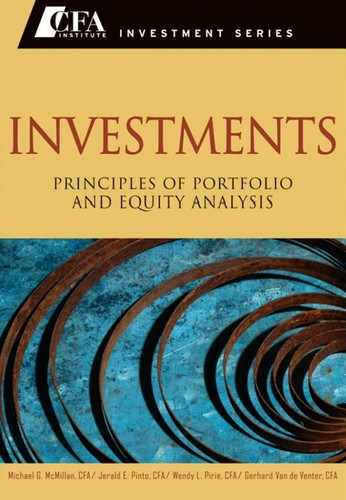FOREWORD
As I read Investments: Principles of Portfolio and Equity Analysis, I was struck by how much the investment profession has evolved over the past 40 years. Although the changes have been mostly for the better, the market events of the past decade suggest that we still have more to learn in order to avoid repeating some of our recent mistakes. We witnessed the bursting of two bubbles—technology and housing/credit—which resulted in a lost decade for equities: The S&P 500 generated negative returns for the 10 years ended December 2009.
I remember learning modern portfolio theory as a student when it was indeed relatively modern. Although analytical techniques for managing portfolios have improved since the 1970s, the investment landscape has become much more complex. The number of markets, institutions, and securities has exploded alongside improvements in security selection/analysis, portfolio construction, and risk management. Aided by ever-increasing information and computing power, institutional investors have become bigger, more numerous, more global, and seemingly more sophisticated. They have attracted the best and brightest from the world’s leading universities. These growing armies of professional investors all compete to be the next Warren Buffett or top hedge fund manager.
New investment texts that keep up with the changing markets and analytical techniques are needed. Investments: Principles of Portfolio and Equity Analysis is a valuable addition to the bookshelves of all investment professionals and students of finance. It has kept pace with the changes in the institutional aspects of investing, as well as the advances in asset pricing and portfolio theory and the practical applications of such tools.
As chief investment officer of Georgetown University, I am responsible for investing its endowment. I also teach investment courses in the MBA program at Georgetown. I am a consumer of this book for both parts of my professional life. As an endowment manager, I know that our investment process involves asset allocation, investment manager selection, portfolio construction, and risk management. The governance for this process is set forth in our investment policy statement. Thoroughly covering all these topics, Investments: Principles of Portfolio and Equity Analysis discusses the theory and application of how endowments, pensions, and other institutions invest their sizable pools of capital. Although we are not directly involved with security selection at our endowment, it is important that we understand the best practices followed by investment managers (e.g., mutual funds, hedge funds, and other investment advisers) to help us in our selection of such managers. We must also be able to recognize opportunities for managers to add value relative to a passive index. Although many investors scoff at the notion of market efficiency, most managers fail to beat passive benchmarks. This book does a wonderful job of addressing not only market efficiency and whether and when active management can add value, but also the institutional details of investing—the mechanics of trading and custody; the array of institutions (e.g., endowments, pensions, and sovereign wealth funds); and the growing number of investment vehicles available to institutions (e.g., exchange-traded funds [ETFs] for passive implementation and hedge funds for active management).
As someone who spans both the academic and the real world of investing, I understand the challenge and importance of writing a book that is able to cover and meld both investment theory and implementation. I believe readers will find that Investments: Principles of Portfolio and Equity Analysis succeeds on both fronts. The book will help professional investors understand a broad body of investment theory. More importantly, it will help them apply this knowledge to the actual practice of investing.
Lawrence E. Kochard, CFA
Chief Investment Officer
Georgetown University
September 2010
